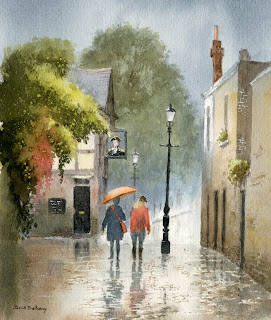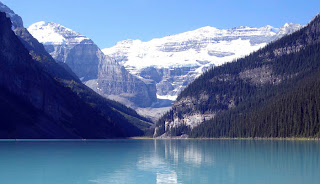I’ve just returned from a trip to South Greenland with my friend Torben Sorensen, hence the lack of blog posts over the past month. Our objective was to sketch and paint the spectacular mountains near Nanortalik, which is about 45 miles north-west of Cape Farewell, the southernmost tip of Greenland. To gain access to the area we hired an inflatable zodiac to go up Tasermiut fjord, a 50-mile stretch with stunning peaks on either side: a rather crazy idea as neither of us had ‘driven’ such a boat before, and perhaps when we found it had a hole in the bottom we should probably have abandoned the idea rapidly.
We carried on, and had to do quite a bit of baling out, as well as heaving the craft over rocks and beaches at anything but high tide. Sunny weather blessed us most of the time, but clouds and cloud streamers added greatly to the atmosphere. When you can see everything the view tends to lose its aura of mystery.
Watercolour, of course, is supreme in conveying a sense of atmosphere. This is a rough watercolour sketch of icebergs near Cape Farewell, done on cartridge paper, which generally dries rather quickly and so makes laying complicated watercolour washes quite difficult, as in this case where I’ve had to work the darker sky round the light foreground berg. Even wetting the paper first still leaves one prone to ugly brushmarks across the cartridge paper. However, as it’s just a sketch this doesn’t matter. The important thing was to capture the subtle colours in the ice, the slightly darker overall tones on the further skyscraper-like icebergs, and a general sense of the atmosphere. At the same time I wanted to suggest the coldness of the Arctic sea. These aspects are difficult to render with a pencil.
I regard sketches as working documents which will give me all the information I need to complete a full watercolour painting at home. Photographs help a lot, but often lose the subtleties of tone and colour that is needed to produce an authentic portrait of the scene. And naturally, being out in the natural wilderness sketching is a wonderful therapy, especially when you know that you really don’t have to exhibit the result!



 I enjoy working on hot pressed paper, although it can be a little more challenging for the inexperienced watercolourist because it dries so much more rapidly than a NOT or rough paper. The advantages of using a hot pressed surface are that you can achieve really sharp, crisp edges, and it lends itself to detail. Colours can also appear more vibrant. The biggest dangers caused by the quicker drying is the possibility that you may find runbacks forming and messy brushmarks can look unsightly if not enough water is used with your colour application and washes.
I enjoy working on hot pressed paper, although it can be a little more challenging for the inexperienced watercolourist because it dries so much more rapidly than a NOT or rough paper. The advantages of using a hot pressed surface are that you can achieve really sharp, crisp edges, and it lends itself to detail. Colours can also appear more vibrant. The biggest dangers caused by the quicker drying is the possibility that you may find runbacks forming and messy brushmarks can look unsightly if not enough water is used with your colour application and washes.
